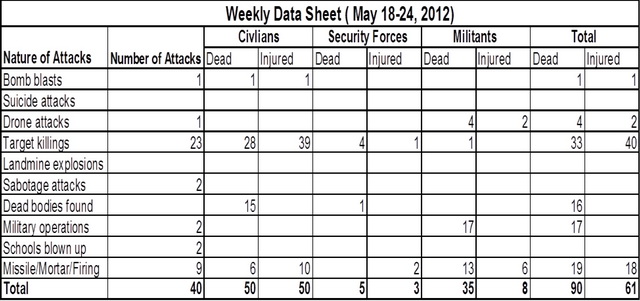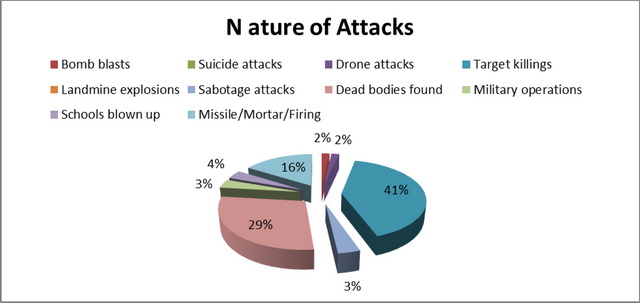The wave of violence further subsided during the current week as compared to the past few weeks. Meanwhile Karachi continued to seethe under persistent sectarian, criminal and ethno-political violence, which has tossed the security and stability of the largest metropolis of Pakistan. The total death toll in the city during the last eight weeks reached 220, and during past 24 days, to 90. Out of the total 220 deaths in the city, almost 190 were the direct consequence of ethno-political violence in the city. Thus contrary to the past weeks, where Federally Administered Tribal Areas (FATA) were the epicenter of violence, during the current week violence was evenly spread across all the familiar violent terrains i.e. FATA, Khyber Pakhtunkhwa (KP), Karachi and Balochistan. The data collected (through ten newspapers that CRSS uses as the source) suggests that 90 persons perished in 40 incidents of violence across the country during the reported week (for details see data sheet).These violent incidents also left 61 people injured across the country. Number of injured decreased from last week 113 to 61.
As a common trend witnessed in the past few weeks, the civilians continued to be the prime target of violence across the country as 55 percent of the total casualties were of the civilians, whereby 50 civilians were killed and 50 others were wounded. Meanwhile military vs. militants– clashes in different areas of Khyber Pakhtunkhwa (KP) and FATA resulted in 17 deaths. Furthermore, one CIA operated drone strike was also reported during the week, killing four and injuring two suspected militants in Datakhel village of Miramshah, North Waziristan Agency (FATA). The sabotage campaign launched by the militants continued to raze state infrastructure and undermine stability; as portions of railway tracks were blown up in Pirkaniabad area of Sariab in Quetta and Noshki districts of Balochistan. Two schools were also blown up by the suspected militants in different areas of KP.
Three sectarian attacks were also reported during the week, killing four, including two Shia Muslims belonging to the ethnic Hazara community based in Quetta, Balochistan and two activists of Sunni Tehrik in different areas of Karachi, Sindh. Furthermore, fatalities due to the target killings declined during the current week. The death toll resulting from this kind of violence constituted 36 percent of the total casualties, down from 38 percent in last week. As the pie chart illustrates, some 57 percent of the total violent attacks were target killings in nature. This indicates that target-killing remains the preferred weapon in the hands of violent actors to inflict violence upon rivals (see the pie chart below).
The data underscores that of the total 23 incidents of target killings, a staggering 69 percent took place in Karachi alone, killing 26 people (78 percent of the total killed in target killings) and injuring 35 others (87 percent of the total injured in target killing incidents). Militant casualties due to the ongoing military operation in KP and FATA region, dropped by 33 percent as 17 militants were killed this week as against last week 24. Total number of militant casualties in various incidents however remained the same, 35. Meanwhile, five security personnel were also shot dead during clashes with miscreants during the course of the week.
Moreover, sixteen dead bodies, including of an Assistant Sub-Inspector (ASI) of the police, were also recovered from different areas of Sindh, KP and Balochistan provinces. In sum, violence across the country receded slightly. The number of violent incidents also dropped from last week 63 to 40 this week; the death toll dropped marginally from last week 100 to 90 this week.
A closer look into the trends and terrain of violence underlines that the intensity of the ongoing urban violence in Karachi is rapidly overshadowing all other areas (geographical) and forms of violence in the country. At the same time, sadly enough, violence in Karachi is not getting the attention of those political actors, who matter in the country, and thus in the city. Firing on a rally, organized by the Sindh nationalist parties is also a stark reminder of the scale of political divineness among the political parties in the province. It also underscores that out of exasperation, political actors are turning towards violent means to make themselves heard.
Sources
- The News
- Dawn
- The Express Tribune
- Pakistan Today
- Daily Times
- The Frontier Post
- Jang (Urdu)
- Daily Mashriq (Urdu)
- Aaj (Urdu)
- The Nation


